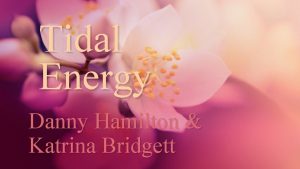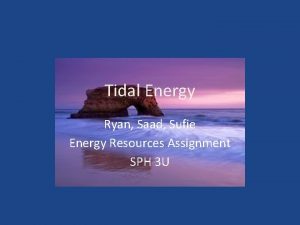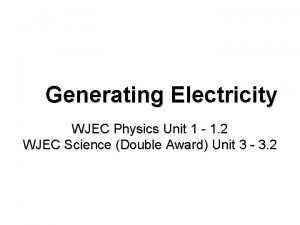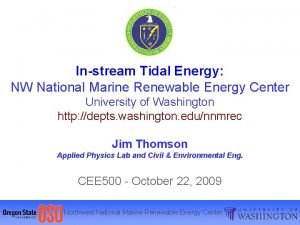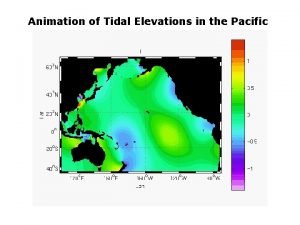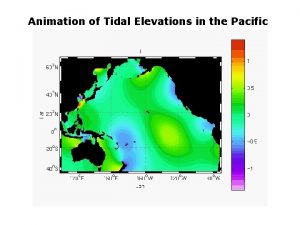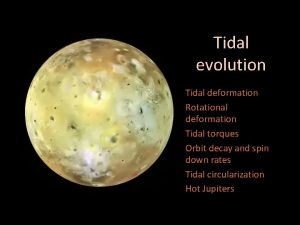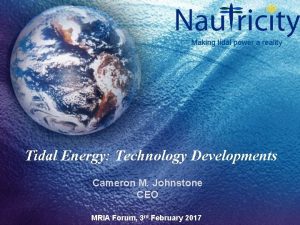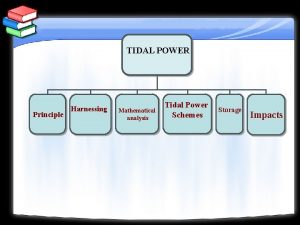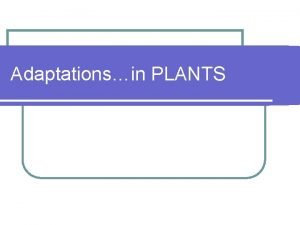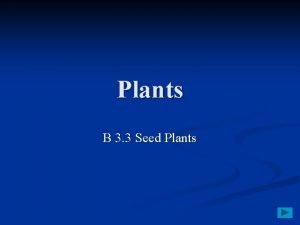TIDAL POWER PLANTS THE TIDAL ENERGY Tidal power










- Slides: 10

TIDAL POWER PLANTS

THE TIDAL ENERGY • Tidal power facilities harness the energy and fall of tides. from the rise • Two types of tidal plant facilities. • Tidal barrages • Tidal current turbines • Ideal sites are located at narrow channels and experience high variation in high and low tides.

BASIC PHYSICS OF TIDES • Gravitational pull of the sun and moon and the pull of the centrifugal force of rotation of the earth-moon system. • There are two high tides and two low tides during each period of rotation of the earth. • Spring and Neap tides depend on the orientation of the sun, moon, and the earth. • When a landmass lines up with the earth-moon system, the water around it is at high tide. • When a landmass is at 90 to the earth-moon system, the water around it is at low tide. ▫ High spring tides occur when the sun and moon line up with the earth. This occurs whether they are either on same or opposite side. ▫ Low neap tides occur when the sun and moon line up at 90 to each other. • Flood Currents: currents moving in the direction of the coast. • Ebb Currents: the current receding from the coast

TIDAL BARRAGE • Utilize potential energy • Tidal barrages are typically dams built across an estuary or bay. • consist of turbines, sluice gates, embankments, and ship locks.

TYPES OF TIDAL POWER PLANTS • Single basin System • Ebb generation: During flood tide basin is filled and sluice gates are closed, trappin water. Gates are kept closed until the tide has ebbed sufficiently and thus turbine s spinning and generating electricity. • Flood generation: The basin is filled through the turbine which generate electricity flood tide. • Two way generation: Sluice gates and turbines are closed until near the end of th flood tide when water is allowed to flow through the turbine into the basin creating electricity. At the point where the hydrostatic head is insufficient for power generati sluice gates are opened and kept open until high tide

• Double basin system There are two basins, but it operates similar to an ebb generation, single basin system. The only difference is that a portion of the electricity is used to pump water into the second basin allowing storage.

CURRENT SITES OF TIDAL BARRAGES • La Rance, Brittany, France • The first and largest tidal barrage power plant • Constructed between 1961 and 1967. • Situated on the Rance River. • Contains 24 reversible 10 MW bulb turbines generating a capacity of 240 MW and a net power output of 480 GWh per year. • Two- way generation system and pumped storage. • Annapolis Tidal Generation Facility on the Bay of Fundy, Canada • Constructed between 1981 and 1984. • Generating capacity of 20 MW and a net output of 30 GW h per year. • Further development is being considered in the Bay of Fundy.

TIDAL CURRENT TURBINES • Extracts kinetic energy from moving water generated by tides. • Operate during flood and ebb tides. • Consists of a rotor, gearbox, and a generator. These three parts are mounted onto a support structure. There are three main types: • Gravity structure • Piled structure • Floating structure

PROS AND CONS OF BOTH TIDAL POWER FACILITIES Tidal Barrages • Mature technology that has been around for nearly 50 years. • Reliable energy source. BUT • High costs of construction • Environmental impacts on marine life • Low power output in comparison to other energy source like coal and nuclear power plants Tidal Current Turbines • Able to utilize both ebb and flood tides. • Tidal current turbines are not large massive dam structure. BUT • Tidal current turbine technology is young in its development. • Installation and maintenance challenges.

THANK YOU
